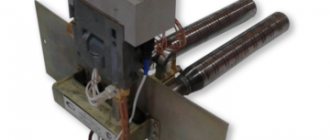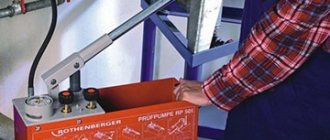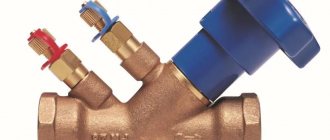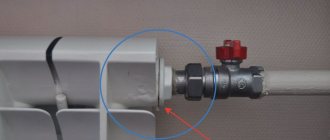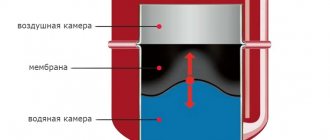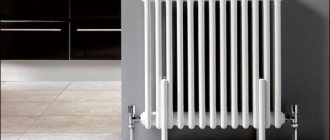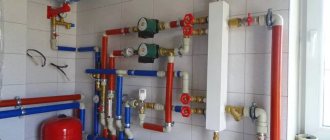The thermostatic head for heating radiators belongs to the control valves of a water heating system. Experts call it a radiator valve or a thermostatic valve. The device appeared in Russia relatively recently, and was immediately included in the appropriate regulatory framework as a legitimate element of a water heating system.
The thermostat is designed to regulate the heating level of one heating radiator or a chain of series-connected batteries. With its help, you can set an individual temperature regime in one of the rooms of your house or apartment. The versatility of the device lies in the fact that it is compatible with any radiator models.
When is a thermal head needed and when is it not needed?
Thermal head is a device with an air temperature sensor that is installed on the radiator.
It allows you to save on heating, and significant amounts. The thermal head allows you to turn off the radiator when the room is already warm enough - and the desired temperature can be set directly on its body. The principle of its operation is quite simple: the thermostatic insert compares the set temperature on the thermal head with the actual temperature in the room, and pushes the rod in the desired direction. The rod, in turn, slightly opens or closes the flow through the thermostatic valve on the radiator supply, regulating its thermal power.
Currently, there are a large number of thermal heads on the market with a variety of connections (threaded, clip-on), with varying adjustment accuracy. They can be made of plastic of different colors, chrome-plated, or in a designer case.
There are even digital thermal heads with a screen! The cost of thermal heads ranges from 500 to 4000 rubles, while it allows you to save up to 30% on monthly heating payments. Moreover, they allow you to set different temperatures in different rooms - after all, all people feel “comfort” differently. It would seem that you can install them always and everywhere... but no.
There are situations when thermal heads are not needed. For example, in the case where you plan to heat a large and open space with a large number of radiators, you can get by with one wall thermostat. This is the only thermostat in the heating system that will compare the actual air temperature with the required one and regulate the operation of the heating system. In this case, it will not shut off the supply to one or more radiators, but will control the boiler.
How important and necessary is a thermal head?
The thermostatic head for a heating radiator allows you to optimize energy consumption, which can bring significant savings in thermal energy throughout the heating season. Using a heating boiler, you can raise or lower the heating temperature in all heating radiators at the same time.
However, this is not always necessary, since different rooms have different needs for the level of heating. The bedroom, children's, living room, dining room and hall need a temperature of 200 - 220, in the bathroom a comfortable level of air heating is desirable around 240 C, and in utility rooms 160 C is sufficient.
Level 120 and 70 for special occasions. By installing thermostatic heads, homeowners can adjust the temperature in each room according to their wishes.
Types of heads by design
Thermostatic devices are distinguished by type of design. They are selected depending on the characteristics of the pipeline of a particular heating system and the method of installation to the radiator.
It is also necessary to take into account the peculiarities of the head installation. This node was always located horizontally. In this position the device will be more effective. The head will be better washed by air currents.
There are devices on sale that stand alone without radiator valves or together with them. The Danfoss thermostatic valve, for example, has exactly this arrangement. But the company produces completely different systems. Instead of a scale, this product has a special diagram on it, according to which you can make precise adjustments.
But the use of such equipment is not always advisable. In this case, instead of automatic solutions, you can use other types of valves. The difference here is that the adjustment is carried out not automatically, but in manual mode. Adjustable valves and thermal heads are installed on the supply line. It is recommended to install simpler fittings at the return outlet from the battery.
Types of thermal heads and their operating principles
Thermal heads are classified as shut-off and control valves.
There are three types of thermostatic heads:
- manual;
- mechanical;
- electronic.
The functions are the same in all, but the implementation methods are different. Depending on the last parameter, they have different capabilities.
What are manual thermal heads?
In terms of design, thermostatic heads duplicate a standard faucet. By turning the regulator, you can regulate the volume of coolant transported through the pipeline.
By setting your thermostat just 1° lower, you can save 6% on your annual energy bill in one year.
They are mounted instead of ball valves on opposite sides of the radiator. They are reliable and inexpensive, but they will have to be controlled manually, and turning the valve every time, relying solely on your feelings, is not very comfortable. Basically, such thermal heads are installed on cast iron batteries.
If you move the valve stem several times a day, the valve handwheel will become loose. As a result, the thermal head will quickly fail.
Features of mechanical thermal heads
Mechanical type thermal heads have a more complex design and they maintain the set temperature automatically.
The device is based on a bellows in the form of a small flexible cylinder. Inside it is a temperature agent in liquid or gaseous form. As a rule, it has a high coefficient of thermal expansion.
As soon as the set temperature exceeds the norm, under the influence of the internal environment, which has greatly increased in volume, the rod begins to move.
As a result, the cross-section of the thermal head passage channel narrows. In this case, the battery capacity decreases, and, consequently, the coolant temperature decreases to the set parameters.
As the liquid or gas cools in the bellows, the cylinder loses its volume. The rod rises, increasing the dose of coolant passing through the radiator. The latter gradually warms up, the balance of the system is restored and everything starts all over again.
A positive result will only be if there are thermostats in all rooms and on each radiator.
Devices with bellows filled with liquid are more popular. Although gases have a faster reaction, their production technology is quite complex, and the difference in measurement accuracy is only 0.5%.
A mechanical regulator is more convenient to use than a manual one. He is fully responsible for the microclimate in the room. There are many models of such a thermal valve, differing from each other in the way the signal is sent
The thermostatic head is mounted so that it is oriented towards the room. This will improve the accuracy of temperature measurement.
If there are no conditions for such an installation, install a thermostat with a remote sensor. It is connected to the thermal head by a capillary tube 2 to 3 m long.
The feasibility of using a remote sensor is due to the following circumstances:
- The heating device is placed in a niche.
- The radiator has a depth of 160 mm.
- The thermal head is hidden behind the blinds.
- The window sill above the radiator is wide, despite the fact that the distance between it and the top of the battery is less than 100 mm.
- The balancing device is located vertically.
All manipulations with the radiator will be performed based on the temperature in the room.
How are electronic thermal heads different?
Since, in addition to electronics, this thermostat contains batteries (2 pcs.), it is larger in size than the previous ones. The rod here moves under the influence of the microprocessor.
These devices have a large set of additional functions. So, they can set the temperature by the clock - at night the room will be cooler, and by the morning the temperature will rise.
It is possible to program temperature readings for individual days of the week. Without reducing the level of comfort, you can significantly save on heating your home.
Although the batteries have enough charge to last for several years, they still need to be maintained. But the main disadvantage is not this, but the high price of electronic thermal heads.
The photo shows a thermal head with a remote sensor option. It limits the temperature to a set value. Adjustment possible from 60 to 90°
If a decorative screen is installed on the radiator, the thermal head will be useless. In this case, you will need a regulator with a sensor that records the external temperature.
How does the system work?
The sensor device can be schematically represented as a regular valve or tap with a thermal head for a radiator. In contact with the hot liquid is a thermostatic valve, which in its simplest form is a spring with a piston. The elastic element is connected to the working volume, which contains a gaseous substance that is sensitive to temperature.
The pressing force is regulated by the rotary scale knob, so the required temperature in the room is set. Depending on it, a piston moves, blocking the flow of liquid. The device is mounted with union nuts, this allows you to change the element if parts of its design fail. They provide additional fluid supply through ball valves in case of breakdown of the automatic control system.
Electronic thermostatic head device.
The electronic thermostat for a heating radiator has a fairly simple device. All elements of these devices are assembled in a compact housing, which is screwed onto the radiator valve. The sensor monitors the external temperature readings. It transmits readings to the controller, which sends signals to the executive shut-off valves. No human intervention is required when adjusting the temperature.
In addition to the listed elements, electronic thermostats for heating radiators include a display. It displays detailed information about the selected settings, the current temperature indicator - both external and coolant temperature. To control the device, use the buttons on its front panel. Devices with remote control capabilities using a remote control are also available for sale.
Heating radiator connection diagrams
Lateral connection of radiators is the most common with regard to the heating system in a city apartment. To correctly connect the batteries according to this scheme in a private house, the pipes are routed from the side along the wall and connected to the two battery pipes at the top and bottom. A pipe that supplies coolant is usually connected to the upper branch pipe, and a return circuit is connected to the lower branch pipe. They often do the opposite, but in this case the heat transfer efficiency of the device decreases by 7%.
Diagonal connection of batteries is considered the most effective. To connect the batteries according to this scheme, perform the following steps: first, connect the coolant supply to the upper pipe, and the return pipe to the lower pipe, which is located on the other side of the device. Thus, the coolant inside the battery begins to move diagonally, hence the name of the circuit. Its effectiveness depends on how evenly the water is distributed inside the radiator. Very rarely, several battery sections may remain cold. This happens if the pressure or throughput is too weak.
The lower connection of the radiator can be found not only in single-pipe circuits. This is also used in two-pipe systems, but only in private buildings with one or two floors. This scheme for connecting heating radiators is considered insufficiently effective. According to experts, such wiring helps reduce heat transfer from heating radiators by 20-30%. In this case, the installation of a circulation pump will be required, which leads to an increase in the cost of all processes, and additional costs will also be required for the electricity consumed during operation of such a pump. To calculate the required power of radiators, you will need a large number of different coefficients.
Correct installation
Thermostats can be installed both at the input of the heating battery and at the output, the main thing is to choose the right installation location. There are several recommendations for this.
Recommended installation height, which is specified in the technical specifications of the device. The main technical characteristics are developed at the factory, through testing and calibration, which are carried out at a certain height. This height corresponds to the upper radiator manifold. Typically this corresponds to a height of about 0.8 meters. At this height it is convenient to carry out all manipulations with this device.
Installation diagrams for heat regulators for radiators
When connecting batteries at the bottom (saddle), when the pipes are located only at the bottom, you need to look for appropriate thermostats. As an option, you can install a thermostat with a remote temperature sensor or reconfigure the thermostat, which is not so simple and is unlikely to be possible without specialists.
The installation technology is no different from the installation technology of conventional shut-off valves, but taking into account the direction of movement of the coolant.
When installing thermostats on radiators in apartment buildings, you should take into account the fact that all apartments are connected to the system. If you do not install a bypass, in the form of a pipe that connects the upper and lower pipes, then the thermostat will regulate the temperature of all apartments connected to the riser.
If you have a similar wiring (there may not be a pipe on the right), a bypass is required. The thermostat should be installed immediately behind the radiator
It is quite natural that no one needs this: neither the neighbors, nor the owner of the apartment. Moreover, such a connection can result in a considerable fine if the relevant services find out.
Basic criteria for choosing a thermal head
Today, the heating engineering market is filled with a wide range of thermal heads of various designs, mostly manufactured by branded companies. In order for the consumer not to get confused among this variety of models, experts recommend being guided by the following selection criteria.
- It is advisable to select thermal heads from the same manufacturer for heating radiators.
- When choosing a device, you should give preference to those models that require a minimum of additional fittings and fastening and connecting elements.
- If a small room includes one or two living rooms, then it is advisable to install manual valves with thermal heads in each of them.
- In one-story buildings, it is advisable to install mechanical thermostats and thermostat heads with remote sensors.
- In two and three story townhouses, owners can choose to have wireless thermostatic heads. They must be installed in houses connected to the Smart Home system.
- The products of a branded manufacturer, compared to mass-produced counterfeits, despite their high cost, will not let you down for many years.
- The anti-vandal casing will protect against careless attempts to interfere with the device settings.
- The design of the thermal head should not contrast with the background of the radiator and fit harmoniously into the interior of the room.
- In order not to run into a fake, you need to ask the seller for a quality certificate.
Kinds
According to the method of transmitting the signal to the thermal element, it can come from the coolant, indoor air. The valve of different types can be almost identical. They will differ in the thermal head. Today, all existing varieties can be divided into 2 types: mechanical and electronic. Devices have their own characteristics, which affect their performance characteristics.
The devices differ not only in the type of material, but also in the installation method. They can be of angular or straight (pass-through) type, depending on the type of connection. For example, if the main is connected to the side, a direct type valve is installed. The corner method is used when connecting from below. The valve option is chosen to be the one that fits best into the system.
The choice between them depends on the preferences of the buyer and his financial capabilities. Products can be designed for a specific type of thermoelement. To understand the differences between thermostats, you need to briefly note their main nuances.
Mechanical
Mechanical thermostats are easy to use, precise and consistent in use. They do not need a network connection. Manual products are different from their electronic counterparts. They work on the principle of a regular faucet: the regulator is turned in the desired direction, allowing the required amount of coolant to flow through. The devices are cheap, but not the most convenient, since to change the heat transfer you need to manually turn the valve each time.
If you install them instead of ball valves, you can use any of them to adjust. The devices are technologically advanced and do not require preventive maintenance. However, often there are no markings at the inlet and outlet of radiators of this design to adjust the heating temperature. Almost always you have to set it experimentally.
Before installing such structures, it is necessary to adjust them, as well as install hydraulic resistance. Smooth adjustment is carried out due to the throttle mechanism, which is located inside the device. This can be done on one of the valves (inlet or return). The operation of a mechanical thermostat depends on the hot and cold points inside the room, as well as the direction of air movement in the room. Another disadvantage is the fact that they react to the operation of household appliances with their own thermal circuits (for example, refrigerators, electric heaters, and hot water pipes).
Electronic
Such modifications are more complex in design compared to manual analogues. With their help you can make your heating system flexible. They not only allow for temperature control of an individual radiator, but also provide control of the main components of the system, including the pump and mixers. Depending on the model, programmable devices are equipped with different types of sensors.
The electronic mechanism can measure the ambient temperature of a specific space (the place where it is installed). Using the software, the received data is analyzed and a decision is made to reduce or increase the temperature. Such a mechanism can be analog or digital. The digital version has 2 modifications: its logic can be open or closed.
The difference between the categories is that products with closed logic are not able to change the functioning algorithm. They remember the level of the initially set temperature and maintain it. Analogs of open logic are able to independently select the desired control program. However, they are rarely used in domestic conditions, since it will be difficult for the average buyer to initially program them, selecting the desired options from the many built-in functions.
Rating of popular manufacturers
Lists of the most popular manufacturers of thermal heads help the consumer to correctly navigate the wide range of thermostats for radiators on the heating engineering market. Based on an analysis of information published on the Internet, the following number of companies is presented:
- Valtec;
- Danfoss;
- Oventrop;
- Thermo;
- Honeywell;
- Caleffi;
- Salus.
Valtec
The company produces reliable heating devices and thermostatic heads. The brand is of Italian origin, although all production facilities are located in Southeast Asia. One of the models of thermostatic heads presented on the Russian market, VT.1000.0.0, allows you to automatically regulate the coolant flow with high accuracy depending on the set temperature in the room.
pros
High precision settings. Beautiful design. Long service life.
Minuses
So far there have been no negative reviews.
Danfoss
The well-known Danish company Danfoss has been developing energy-saving technologies for more than 60 years. Its products, and in particular thermal heads, are very popular in the Russian heating engineering market. Programmable electronic devices are often included in the Smart Home system. The microclimate in the house can be controlled by software installed on a smartphone via WI-FI.
pros
High efficiency, reliability, beautiful design.
Minuses
High cost of the device.
Oventrop
The success of one of the leaders in the production of fittings for utility networks, including thermostats for radiators, Oventrop, was achieved due to the high qualifications of the engineering staff and the rest of its employees. The most popular models of thermostats are the Uni line. The devices are equipped with a liquid bellows, designed for the maximum temperature in the heating system - 1200 C.
pros
Easy to use. Beautiful appearance. Accuracy of settings.
Minuses
Not compatible with all types of radiators. High price of the device.
Thermo
Founded more than 20 years ago, the Swedish company Thermo quickly took a leading position in the production of heating equipment. Thermal heads from this manufacturer are widely recognized and lead in most ratings. The Royal Thermo RTE 50.30 model should be noted. It is valued for its wide adjustment range - from 6 to 28 degrees Celsius.
pros
Beautiful appearance. Easy to operate. Fits into the interior of any room
Minuses
For correct operation, the coolant must have a temperature of no more than 95 degrees.
Honeywel
An American company specializing in the production of electronic automation control systems is known in Russia as a manufacturer of reliable and efficient heating equipment. Electronically controlled thermal heads feature precise settings.
pros
Beautiful design, simple installation and ease of use.
Minuses
There is no such information yet.
Caleffi
The Italian company Caleffi produces fittings for utility networks for various purposes. In Russia, the company is known as a manufacturer of high-quality thermal heads. One of the programmable Caleffi 210000 models is equipped with a liquid crystal display. Has a large number of settings.
pros
Accuracy of settings. High efficiency and ease of use. Beautiful design.
Minuses
There have been no negative reviews yet.
How to choose
Based on the characteristics of the heating system, as well as the conditions of its installation, various combinations of valves and thermal heads can be used to control the temperature.
So, for example, for use in single-pipe systems it is worth using valves with a higher throughput.
The same applies to those two-pipe systems in which water circulation is carried out by gravity, that is, naturally, without forced mechanisms. In cases where a two-pipe system is used where there is a circulation pump, it is recommended to choose those types of valves where it is possible to adjust the throughput.
After selecting the valve, you need to select the thermal head.
The most common options that can be purchased today are:
- having an internal thermoelement;
- electronic (which can be programmed);
- having an external temperature sensor;
- anti-vandal;
- having an external regulator.
Most often, classic thermostats with an internal sensor version are installed in cases where their axis will be in a horizontal position.
Please note: the thermostat cannot be installed vertically, as the heat emanating from the housing piping will greatly affect the bellows, causing the entire device to function incorrectly.
In addition to vertical installation options, there are also other reasons to purchase a remote version of the sensor:
- if heating radiators with a temperature regulator located on them will be located behind the curtains;
- when there is any other heat source next to the installed thermal head;
- if the location of the battery is under a large window sill.
Very often, in rooms where interior requirements are increased, batteries are covered with decorative screens. Due to this, the internal thermostat will only register the temperature that is inside this casing. In this case, access to the thermal head adjustments will be blocked. Therefore, in such cases, it is recommended to opt for a remote controller with a temperature sensor.
It’s worth knowing: if you haven’t purchased heating radiators yet, you can buy Kermi models with built-in temperature sensors.
If we talk about electronic thermostats with a display, then they come in several types; the first have a built-in control unit, and the second have a removable control unit. The latter have the peculiarity of being able to be disconnected from the thermal head, while it will continue to operate in the same mode. The purpose of such models is to regulate the temperature in different modes at different times of the day. This makes it possible to reduce the heat level during the day, and at night, when everyone in the house is sleeping, to raise it to the desired level. Due to this, it is possible to significantly save energy.
If there are small children in the family who always want to touch and twirl everything, it is recommended to install anti-vandal thermostats. This will protect the device settings from unauthorized intervention. The same situation applies to options installed in various public buildings, from kindergartens to hospitals.
Features of setting up the Danfoss electronic thermal head
adjusting the valve and thermostat of the thermal battery
By default, the thermostat is set to the energy saving program P 1. You can select the program that best suits your family's lifestyle:
- P 0 – constant temperature 210 C around the clock.
- R 1 – energy saving, in which every night from 22-30 to 6 am the temperature is maintained at 170 C.
- R 2 - an extended energy-saving program, which raises temperatures up to 170 C every night from 22-30 to 6 am and on weekdays from 8 am to 16 pm.
- You can create your own settings in the energy saving program. To do this, press the middle button of the program menu and select the desired one. Using the arrow keys, you can set energy saving periods for weekends, weekdays, all days of the week, or one day.
- Once the settings have been selected, they are confirmed by pressing the bottom key.
What are the criteria for choosing a thermal head?
Thermostatic devices are produced by many manufacturers.
To make the right choice, you need to be guided by the following criteria:
Thermal valve to which the head will be attached
Since the connection can be clip or threaded, you need to pay attention to this point. If the manufacturer is the same, there will be no problems.
View of the threaded connection on the head itself
It can be in the form of a nut with curtains or simply round. In the first case, during installation you need an additional tool to crimp the connection. In the second, everything is much simpler.
The presence of a “skirt”. The head looks better with it, because... it covers the work area.
Material of manufacture. The cheapest are thermal heads in a plastic case. Expensive models have a metal body.
Quality of plastic. Some manufacturers, in order to reduce the cost of their products, use the cheapest type of plastic. The strength of the structure suffers from this, and over time the plastic turns yellow and loses its aesthetic appearance.
Work item type. The choice will have to be made between liquid, gas, electronic and paraffin.
Smooth rotation. The handle should rotate smoothly. This is a sign of good quality. Any cracking, squeaking or jamming indicates a not entirely high-quality product.
Graduation and scale length. For most models it is in the range of +5 – +30 °C. If the graduation scale is located around the entire perimeter of the head, it can quickly wear out.
Availability of anti-vandal casing. It protects against unauthorized access to settings.
Design. Since thermal heads are mainly located in plain sight, their appearance and color scheme are important.
It is not necessary to purchase a ready-made kit consisting of a thermal valve and a thermal head. These devices can be purchased separately.
The gas-filled bellows is not too sensitive to external heat sources. This is a definite plus, but its cost is much higher than that of a liquid bellows
A thermal head equipped with automation benefits a lot, but it is not always effective. There is no point in mounting it on cast iron radiators. This material is very heat-intensive, and since the mass of the battery is large, it has great inertia. Only a manual type of head can work correctly here.
Rules for installing a thermal head
The connection location when installing a thermal head on a radiator does not depend on its type. In any case, this is a pipe that directly supplies coolant to the battery.
For the device to work correctly, air must continuously circulate around it.
Connection recommendations
Each manufacturer gives recommendations regarding connecting the thermal head.
Despite this, there are general installation conditions:
- The housing must be protected from direct ultraviolet rays. Otherwise, the device will not work accurately.
- The thermal head must be open. It should not be hidden by any protective boxes or furniture.
- The device must not be located above heating pipes. In this case, there will be a discrepancy between the room temperature and the area around the head.
- If the device is practically isolated, you need to install a bypass line or install a bypass valve in the area of the supply pipe and return pipe.
- The connected piping must not exert pressure on the valve body.
During installation, the thermal head regulator must be set to maximum. This will ensure the device operates correctly. Immediately before installation, the movement of water or other coolant in the circuit must be shut off and then drained.
It is prohibited to install the thermal head vertically. It should be parallel to the floor. This position ensures that it is not affected by warm air.
Device installation sequence
Installation should begin with cutting the pipes, which is done by stepping back a little from the radiator. The next step is to dismantle the existing shut-off valves. Next, separate the shanks from the valves and screw them into the radiator plugs.
Mount the harness in place, having previously assembled it, connect the pipes. All that remains is to adjust the temperature by turning the thermostat knob until the notches coincide with the existing marks on the body corresponding to a certain temperature.
It is not recommended to overtighten the thermal head mounting nuts, because The materials from which it is made are quite soft. To do this, it is better to use a torque wrench.
It is important that the arrow on the housing points towards the flow of hot coolant in the system. Otherwise, the work has been done in vain, nothing will work. The thermal head can be installed both at the inlet and outlet.
Manufacturers' recommendations regarding the installation level of the device should not be neglected, since it is calibrated for temperature conditions at this height. Basically it is 0.4 - 0.6 m from the floor.
But not all batteries have a top feed; it can also be a bottom feed. If there is no sample suitable in height, the solution is to set the thermal head to a lower temperature.
Since it is cooler near the floor, and the device is set to the temperature that should be at the top edge of the radiator, the room will be hot. To avoid this, you can install a thermal head with a remote sensor. There is also an option to configure the regulator yourself.
Features of setting up
For normal operation of the device, preliminary configuration is required. Before this, turn on the heating and isolate the room by closing the door.
At a certain point, install a thermometer and begin setting up:
- Turn the thermal head to the left until it stops so that the coolant flow is completely open.
- Wait until the temperature rises by 5-6° compared to the original.
- Turn the head all the way to the right.
- When the temperature drops to the desired value, the valve is gradually unscrewed. They stop rotation when noise appears in the radiator and the body becomes warm.
The last position of the thermal head corresponds to a comfortable temperature. It will be constantly supported.
The design of electronic thermal heads includes built-in programs. They make it possible to adjust the temperature with great accuracy - down to 1 degree
The described sequence is suitable for most devices. If it is different, then it is not difficult to complete, since everything is described in detail in the passport.
Rules for installing the control valve
As mentioned above, the greatest efficiency is achieved when the thermal tap is installed horizontally on the radiator.
The thermal head is installed according to special rules, according to which adjustment is necessary only for powerful radiators. Therefore, you should not equip every battery located in a residential area with this device. The greatest efficiency can be achieved if you install the thermostat on the most powerful heating element available in the room.
It is not recommended to install a valve with a thermal head for a radiator on cast iron radiators; this will not give the desired effect. The reason for this is the inertia of cast iron batteries, resulting in a large adjustment delay. Consequently, installing a thermal head in this case makes no sense.
The best option is to install the valve on the supply pipe while connecting the battery to the system. Otherwise, it is necessary to insert the device into the finished system. For this purpose, individual elements of the heating circuit are dismantled and the pipes are cut, first turning off the tap. It is quite problematic to make insertions into metal pipes, so you need to study the instructions on how to install a thermal head on a heating radiator.
After completing the installation of the thermostat, you need to fix the thermal head. This process is not particularly difficult and is as follows:
- There are corresponding marks on the body of both elements that must be aligned.
- To fix the thermal head, you need to lightly press the device.
- A dull click will indicate the correct position and installation.
Anti-vandal thermostats are more difficult to install. In this case, to solve the problem of how to install a thermal head on a radiator, you need a 2 mm hex key.
The work proceeds in the following order:
- Using dowels, the plate is secured to the wall.
- The device body is fixed to the plate.
- The capillary tube is fixed to the wall using clamps.
- Install the valve with the thermal head for radiators, aligning the marks, and press it against the main body.
- Tighten the fixing bolt using a hex key.
With the help of thermostats, you can not only regulate the temperature, but also limit pins on the back wall. The devices allow you to set the minimum and maximum values. In this case, the wheel will no longer turn beyond the established limits.
Selecting the optimal thermostatic head for a radiator is not particularly difficult. The main condition is that the option must correspond to the heating system, regardless of whether it is at the design stage or already presented in assembled form. In addition, you should take into account the installation features of each type of thermostat. According to experts with many years of experience, programmable devices allow you to get maximum benefits and savings.
Principle of operation
The operation of a thermal head for a heating radiator is as follows:
- Markings on the rotary ring indicate the 4 main positions of the regulator. By combining a certain mark on the scale with the body mark, the operating mode of the device is set;
- if the air begins to heat up above the established norm, then through the slots of the rotary cap it begins to heat the bellows with the working substance;
- the heated substance begins to increase in volume, which sets the rod in motion;
- the rod, in turn, begins to close the passage hole through the spool, thereby reducing the flow of coolant into the battery;
- as a result, the air in the room will begin to cool, and the bellows with the working fluid will cool accordingly;
- the reverse process occurs, and hot water will be supplied to the radiator with the required intensity.
The control and accuracy of adjustment may vary between devices. However, the operating principle is the same for all mechanical models.
Thermal head, how it works, experiment.
Purpose and principle of operation of thermal heads
Temperature control in heated rooms is carried out in stages. The first stage of adjustment is setting the required coolant temperature on the boiler. In the case of centralized heating, this stage is absent - the coolant enters the devices at the temperature of the supplier organization according to the temperature (seasonal) schedule.
But temperature control (refers to a qualitative control method) on the boiler cannot provide the necessary conditions in rooms of various purposes and volumes. Even according to the requirements of SNiP, the air temperature in individual residential premises varies from 16 to 25C.
To solve this problem, quantitative regulation is carried out on heating radiators - a change in the volume flow of coolant through the device per unit time. In accordance with the mass flow of water, a certain amount of heat is released into the room through the device.
Quantitative adjustment is carried out in 3 ways:
- Manual valve adjustment;
- Manual adjustment with ball valves;
- Semi-automatic (automatic) regulation by thermostatic valves with thermal heads.
Manual adjustment of coolant flow has low accuracy (especially when using ball valves) and requires constant manipulation of shut-off valves when the air or coolant temperature changes. This process is automated using thermal heads installed on thermostatic valves.
The operating principle of thermal heads is implemented using the thermophysical properties of materials to expand and contract when the ambient temperature changes.
The container with the substance is built into the body of the thermal head; when it expands, it puts pressure on the valve actuator and it covers the flow area, reducing the coolant flow and, accordingly, the amount of heat transferred. When cooled, the container with the substance contracts and a spring-loaded valve opens the passage for water.
Features of the thermal head structure
The most popular thermal head consists of a body, a bellows, a locking element, a pusher, a rod (closing cone), a return spring, sealing and fastening elements.
The amount of coolant flowing into the radiator is controlled by the valve device. Most products are equipped with this element.
The plastic body is made by hot stamping. It can be either transparent or colored - from white to black. The bellows is made of brass or galvanized steel. In most models, the thermal head housing for installation on radiators and the thermostatic valve are compatible.
The bellows filler, such as gas condensate, has the fastest response to temperature fluctuations.
Two stainless steel springs help open and close the rod. One of them returns the rod to its original position after the valve closes, and the second - after it opens
There is a locking element at the very top of the body. It is necessary to fix the settings. If the settings have not been changed for a long period or the moving elements of the device are inactive, they may become stuck.
To combat this phenomenon, experts recommend removing thermal heads from the valves as soon as the heating season ends. When thermostatic valves are designed for a pressure of 4 atm or more, the likelihood of sticking is significantly reduced.
There is such a thing as “gestesis” of the head. The smaller it is, the faster the device responds to temperature changes.
